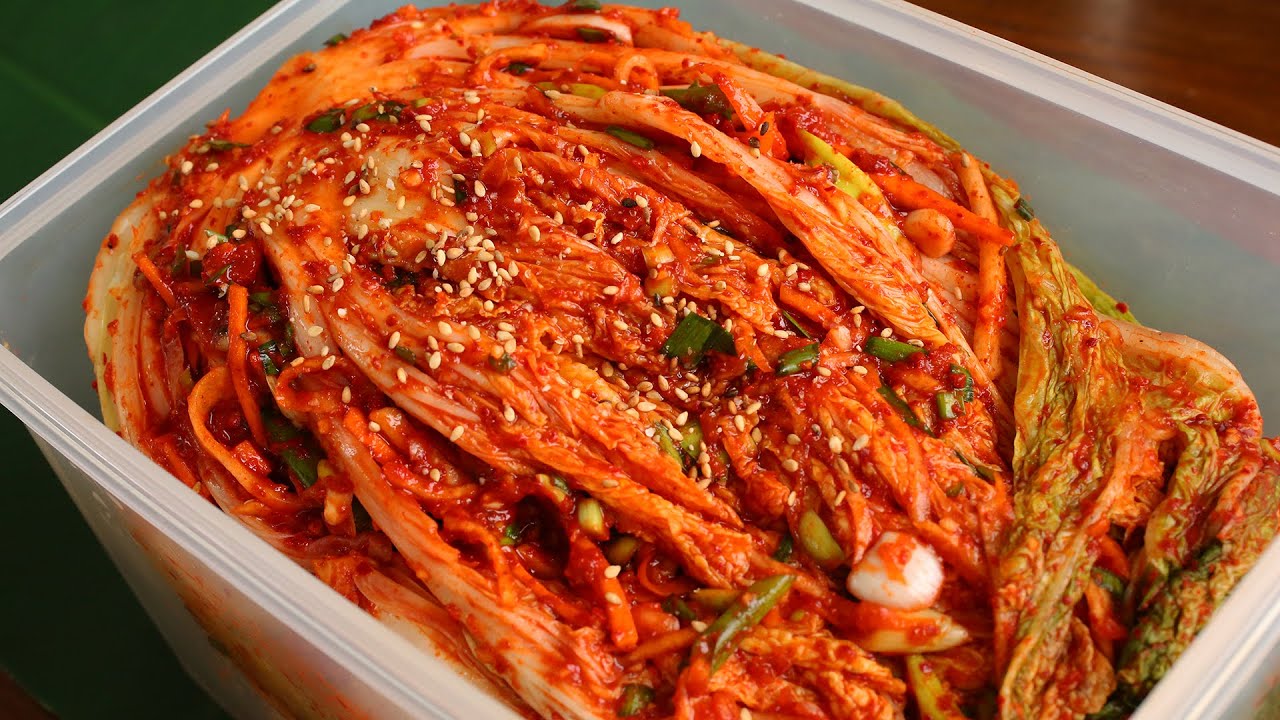Korean Food
canthidium
•
12 months ago
•
100%
Traditional napa cabbage kimchi (Tongbaechu-kimchi: 통배추김치)
 www.maangchi.com
www.maangchi.com
Ingredients
Makes about 8 pounds (3.6 kg) of Kimchi For salting cabbage:
6 pounds (about 2.7 kg) napa cabbage
½ cup Kosher salt (2.5 ounces: 72 grams)
For making porridge:
2 cups water
2 tablespoons sweet rice flour (glutinous rice flour)
2 tablespoons turbinado sugar (or brown or white sugar)
Vegetables:
2 cups Korean radish matchsticks (or daikon radish)
1 cup carrot matchsticks
7 to 8 green onions (scallions), chopped
1 cup chopped Asian chives (buchu), optional (substitute with 3 green onions, chopped)
1 cup water dropwort (minari), optional
Seasonings and spices:
½ cup garlic cloves (24 garlic cloves), minced
2 teaspoon ginger, minced
1 medium onion, minced
½ cup fish sauce
¼ cup fermented salted shrimp (saeujeot) with the salty brine, chopped
2 cups red pepper flakes (gochugaru)
Directions Prepare and salt the cabbage
If the cabbage cores stick out too much, trim them off with your knife over your cutting board.
To split a cabbage in half without shredding the densely packed leaves inside, first cut a short slit in the base of the cabbage, enough to get a grip on either half, and then gently pull the halves apart so the cabbage splits open. kimchi_cut cabbage
Cut a slit through the core of each half, 2 inches above the stem. You want the cabbage leaves to be loose but still attached to the core.napa cabbage_cut (배추)
Dunk the halves in a large basin of water to get them wet. Sprinkle salt between the leaves by lifting up every leaf and getting salt in there. Use more salt closer to the stems, where the leaves are thicker.Salting cabbage cabbage_salting (배추 소금절이기)
Let the cabbages rest for 2 hours. Turn over every 30 minutes, so they get well salted. From time to time you can ladle some of the salty water from the bottom of the basin over top of the cabbages if you want to.kimchi_cabbage salting (배추소금절이기) kimchi_cabbage salting (배추소금절이기)
After 2 hours, wash the cabbage halves a few times under cold running water. Giving them a good washing, to remove the salt and any dirt. As you wash, split the halves into quarters along the slits you cut into earlier. Cut off the cores, give them a final rinse, and put them in a strainer over a basin so they can drain well.
kimchi-cabbage wash (배추씻기)
While the cabbage is salting for 2 hours, and in between the times you’re turning it over, you can make the porridge:
Combine the water and the sweet rice flour in a small pot. Mix well with a wooden spoon and let it cook over medium heat for about 10 minutes until it starts to bubble. Add the sugar and cook 1 more minute, stirring. Remove from the heat and let it cool off completely.
Pour cooled porridge into a large mixing bowl. Add garlic, ginger, onion, fish sauce, fermented salted shrimp, and hot pepper flakes. Mix well with the wooden spoon until the mixture turns into a thin paste.salted fermented shrimp (saeujeot: 새우젓)kimchi_seasoningskimchi_paste (김치양념)kimchi paste
Add the radish, carrot, and green onion, plus the Asian chives (or more green onions) and the water dropwort if you’re using them. Mix well.Kimchi making (김치)kimchi paste (김치속) kimchi paste
Make kimchi
In a large bowl, spread some kimchi paste on each cabbage leaf. When every leaf in a quarter is covered with paste, wrap it around itself into a small packet, and put into your jar, plastic container, or onggi.
Eat right away, or let it sit for a few days to ferment.
kimchi makingwhole-cabbage-kimchifresh-kimchi (포기김치) On fermentation
The kimchi will start fermenting a day or two at room temperature, depending on the temperature and humidity of your room. The warmer and more humid it is, the faster the kimchi will ferment. Once it starts to ferment it will smell and taste sour, and pressing on the top of the kimchi with a spoon will release bubbles from beneath. If you’re using a sealed jar with a lid, be sure to open it once a while, let it breathe, and press down on the top of the kimchi.
Once it starts to fermented, store in the refrigerator to use as needed. This slows down the fermentation process, which will make the kimchi more and more sour as time goes on.
Comments 0